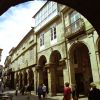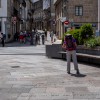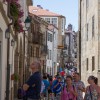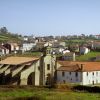- Accede I
- Regístrate I
- carrito
08. Iglesia de San Paio de Antealtares
08. Iglesia de San Paio de Antealtares
Galería de imágenes

Estamos en la Vía Sacra, frente a la iglesia de San Paio de Antealtares. El santo titular es San Pelayo, que siendo un niño marchó desde Galicia a Córdoba para entregarse a cambio de su tío, preso y ya anciano, al califa Abderramán III. Este se enamoró de la belleza y juventud del joven, quien, tras rechazar las tentaciones del califa, fue sometido a tormentos hasta ser finalmente degollado. Pelayo moría mártir en el año 925. Su cuerpo fue tirado al río, pero unos cristianos recogieron sus restos para llevarlos a tierras seguras.
Esta iglesia pertenece al convento de las benedictinas y tiene el privilegio de guardar en su interior el altar encontrado junto al sepulcro de Santiago, las reliquias del mártir San Pelayo, además de un interesante Museo de Arte Sacro.
Ahora miremos a nuestra espalda, de cara a la trasera de la catedral. Esta pequeña explanada ante la puerta de San Paio en la que nos encontramos, fue diseñada por el arquitecto Domingo de Andrade. El autor de la Torre del Reloj de la catedral fue también el encargado de construir la Casa de la Parra a nuestra derecha. La esquina, sabiamente rematada en chaflán, permite enmarcar, desde esta calle tan estrecha, una vista única de la Torre del Reloj.
La torre recibe el curioso nombre de Berenguela, en honor al arzobispo Berenguel de Landoira, que ordenó su construcción en el siglo XIV. Entonces, esta torre sólo era un robusto cubo defensivo coronado de almenas, cuya altura no superaba la posición actual del reloj. Andrade la dotó de su aspecto actual, con una altura de 72 metros, añadiendo el remate y la ornamentación barroca que la distinguen como una de las más hermosas de Europa. De hecho, a una mujer gallega cuando se pone guapa, se le suele decir: ‘Estás hecha una berenguela’.
La torre alberga la mayor de las campanas de la Catedral, conocida también como Berenguela. Sus 6,5 toneladas casi igualan el peso de todas las campanas del Obradoiro juntas. Su nota Do grave puede oírse cuando marca las horas. Tan sobrecogedor es para algunos el sonido, que la tradición popular le atribuye un poder sobrenatural: el de tocar, alguna medianoche, no doce, sino trece campanadas.
Lo cierto es que antiguamente las campanas se utilizaban para comunicar al pueblo lo que acontecía: la muerte de un vecino, un incendio, un ataque, incluso cuando una mujer daba a luz. Esta señal acabó por ser suprimida, pues cada vez que una mujer se ponía de parto, el sonido de las campanas comunicándolo alarmaba a las que aún no les tocaba, adelantando en muchas ocasiones los nacimientos.



































